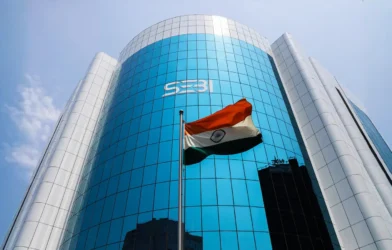Author: Dev Patel | EQMint | General News
Mumbai, October 31, 2025 — Amid ongoing market fluctuations, India’s top mutual fund executives have called on investors to remain calm, stay invested, and leave the management of volatility to professional fund managers. Speaking at the Business Standard BFSI Insight Summit 2025 in Mumbai, industry leaders emphasized that India’s markets remain resilient and that long-term discipline continues to be the most effective wealth-building strategy.
At a panel discussion titled “How Soon Do We Double AUM and Investor Count,” top executives including Navneet Munot (MD & CEO, HDFC AMC), DP Singh (Deputy MD & Joint CEO, SBI MF), Vetri Subramaniam (CEO-designate, UTI AMC), Sid Swaminathan (MD & CEO, JioBlackRock AMC), and B. Gopkumar (MD & CEO, Axis MF) shared insights on investor behavior, SIP growth, and the evolving role of technology in mutual fund distribution.
“Leave Volatility to Fund Managers”
The session opened with a common message from the panel: investors must stay disciplined and avoid reacting impulsively to short-term market movements.
UTI AMC’s Vetri Subramaniam urged investors to “stick to their financial plan and asset allocation” rather than attempt to time the market. “When you’re trying to achieve long-term financial goals, there is no point in second-guessing the market,” he said. “Volatility is part of the investment journey. Leave it to fund managers to manage valuations and risk. The best results come when investors stay invested through market cycles.”
He added that investors who remain committed to their long-term goals tend to benefit the most. “If you stay invested for the entirety of your financial journey, you will reach your goals — irrespective of short-term turbulence,” Subramaniam said.
Markets Remain Strong Despite Volatility
DP Singh of SBI Mutual Fund echoed similar confidence in the Indian market’s resilience. “Our markets are remarkably resilient,” Singh said. “Every correction is seen as an opportunity. What stands out is how retail investors are continuing their SIPs even during market dips — a sign of growing maturity and confidence.”
Navneet Munot of HDFC AMC reinforced the same optimism, citing the long-term strength of India’s financial ecosystem. “We’ve been managing funds for over 30 years,” he noted. “Investors who stayed invested through multiple cycles — from the dot-com bust to the pandemic — have seen substantial wealth creation. Consistency and patience always outperform short-term trading.”
Munot also pointed out that the rise of systematic investment plans (SIPs) has played a crucial role in instilling investing discipline. “Our SIP book has grown from ₹4,000 crore in 2017 to ₹29,000 crore today,” he said. “That growth tells you about the increasing maturity and resilience of Indian investors.”
Growing SIP Ticket Size: From ₹3,000 to ₹5,000
While the number of SIP accounts has multiplied over the last few years, industry leaders agreed that the average ticket size per SIP, currently around ₹3,000, has room to grow. “SIP numbers have tripled in the last five years, but the average contribution remains modest,” said Singh. “We expect the average SIP size to rise to around ₹5,000 in the next three to four years as disposable incomes grow and financial awareness deepens.”
Munot added that financial literacy, technology adoption, and trust would be key drivers of this growth. “Transparency, investor education, and the ease of digital access have helped build tremendous trust,” he said. “Going forward, our focus should be on deepening that trust and improving investor engagement across segments.”
Expanding Reach Through Technology and Education
Technology and digitalization have opened new doors for the mutual fund industry, particularly in smaller cities and towns. Sid Swaminathan of JioBlackRock AMC highlighted how fintech innovations and digital distribution are reshaping investor behavior.
“We already have about 7.5 lakh investors, and 10% of them are entirely new to the mutual fund industry,” Swaminathan said. “Nearly 40% of our retail assets come from beyond the top 30 cities, which is above the industry average.”
He noted that technology — especially AI-driven personalization and multilingual education tools — has made it possible to reach new demographics.
“Artificial intelligence helps us deliver personalized content and financial literacy in multiple Indian languages. Digital education is breaking barriers and encouraging first-time investors,” Swaminathan explained.
Axis MF’s B. Gopkumar agreed that fintechs are playing a critical role in mutual fund penetration. “Fintech platforms are doing much of the heavy lifting,” he said. “By simplifying onboarding, lowering ticket sizes, and enabling digital KYC, they’re helping millions of first-time investors start their journey.”
Gopkumar predicted a symbiotic relationship between fintechs and traditional fund houses in the coming years. “Three years from now, we’ll see many investors who began their journey through fintechs transition to traditional fund houses as their portfolios mature,” he said. “Fintech channels are becoming powerful touchpoints for engagement and investor education.”
Rise of Passive Investing, But Active Funds Still Strong
The discussion also touched on the growing popularity of passive funds — exchange-traded funds (ETFs) and index funds — which are witnessing strong inflows globally and in India.
HDFC AMC’s Munot acknowledged the trend but stressed that active management remains relevant in India’s developing market. “Passive investing is a healthy addition to the investment landscape,” he said. “But India’s active funds have a track record of delivering long-term outperformance. Few global fund houses can match the 25–30-year history of consistent alpha generation that Indian fund managers have achieved.”
Munot emphasized that the choice between active and passive should depend on investor goals and advice. “There’s room for both — what matters is asset allocation and staying invested,” he added.
Building the Next Phase of Growth
The panelists agreed that the mutual fund industry is entering a new phase of expansion, supported by rising incomes, greater financial inclusion, and digital accessibility.
India’s mutual fund industry crossed ₹60 trillion in assets under management (AUM) earlier this year, and industry leaders expect it to double within the next five years. The growth, they said, will be driven by continued SIP participation, deeper penetration into Tier-2 and Tier-3 cities, and greater adoption of hybrid and passive products.
“The Indian investor today is far more aware and confident than ever before,” said Singh. “They’ve seen that markets may be volatile, but the long-term direction remains positive. If we continue to nurture trust, transparency, and education, we’ll see this industry scale new heights.”
The Bottom Line: Patience Pays
In conclusion, all speakers reiterated one timeless message — stay invested, stay patient, and let professionals manage volatility. As Subramaniam put it, “When investors trust the process, time becomes their biggest ally. Volatility may be temporary, but discipline compounds wealth forever.”
For more such insights visit EQMint
Disclaimer: This article is based on information available from public sources. It has not been reported by EQMint journalists. EQMint has compiled and presented the content for informational purposes only and does not guarantee its accuracy or completeness. Readers are advised to verify details independently before relying on them.









